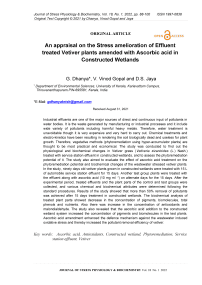An appraisal on the stress amelioration of effluent treated vetiver plants amended with ascorbic acid in constructed wetlands
Автор: Dhanya G., Vinod Gopal V., Jaya D.S.
Журнал: Журнал стресс-физиологии и биохимии @jspb
Статья в выпуске: 1 т.18, 2022 года.
Бесплатный доступ
Industrial effluents are one of the major sources of direct and continuous input of pollutants in water bodies. It is the waste generated by manufacturing or industrial processes and it include wide variety of pollutants including harmful heavy metals. Therefore, water treatment is unavoidable though it is very expensive and very hard to carry out. Chemical treatments and electro-kinetics have been resulting in rendering the soil biologically dead and useless for plant growth. Therefore, vegetative methods (phytoremediation using hyper-accumulator plants) are thought to be most practical and economical. The study was conducted to find out the physiological and biochemical changes in Vetiver grass ( Vetiveria zizanioides (L.) Nash.) treated with service station effluent in constructed wetlands, and to assess the phytoremediation potential of it. The study also aimed to evaluate the effect of ascorbic acid treatment on the phytoremediation potential and biochemical changes of the wastewater stressed vetiver plants. In the study, ninety days old vetiver plants grown in constructed wetlands were treated with 15 L of automobile service station effluent for 15 days. Another test group plants were treated with the effluent along with ascorbic acid (10 mg ml -1) on alternate days for the 15 days. After the experimental period, treated effluents and the plant parts of the control and test groups were collected, and various chemical and biochemical attributes were determined following the standard procedures. Results of the study showed that more than 50% removal of pollutants was achieved after 15 days treatment in constructed wetlands. The biochemical analysis of treated plant parts showed decrease in the concentration of pigments, biomolecules, total phenols and nutrients. Also there was increase in the concentration of antioxidants and malondialdehyde. The study also revealed that the ascorbic acid addition to the constructed wetland system increased the concentration of pigments and biomolecules in the test plants. Ascorbic acid amendment enhanced the defence mechanism against the wastewater induced oxidative stress and thereby increased the pollutant removal efficiency of vetiver.
Ascorbic acid, antioxidants, constructed wetland, phytoremediation, service station effluent, vetiver
Короткий адрес: https://sciup.org/143178341
IDR: 143178341
Текст научной статьи An appraisal on the stress amelioration of effluent treated vetiver plants amended with ascorbic acid in constructed wetlands
Water pollution is a major global problem which requires ongoing evaluation and revision of water resource policy. It has been suggested that it is the leading worldwide cause of deaths and diseases and that it accounts for the deaths of more than 14,000 people daily (West, 2006). Major categories of water pollutants include disease causing organisms, dead organic material, heavy metals, organic chemicals, oil and grease, acids, sediment, heat and radioactivity. Ever-increasing population with industrialization has resulted into an uncontrollable growth of vehicular population. Automobile service and repair shops are the largest small quantity generators of hazardous waste. The most dangerous waste commonly created in autorepair shops is from the solvents used to clean parts. Many of the chemicals that make up the solvents are extremely dangerous to human and the environment (Imevbore and Adeyemi, 1981). The discharge of automobile service station wastewater has been identified as one of the most concerned pollution sources even in rural areas of the world.
Phytoremediation is one of the attractive alternatives to chemical method for the clean-up of the contaminated water or soil. Root zone (constructed wetland) technology is one of the emerging and acceptable technologies in phytoremediation because it can effectively remove all most all types of pollutants from waste waters without harming the environment. It is based on the principle of attached growth biological reactors similar to conventional trickling filters with a combination of aerobic and anaerobic zones created around plant roots. A wide variety of microorganisms present in the root-zone of the plants results in efficient degradation of organics (Anonymous, 2009).
Oxidative stress results from an imbalance between the activities of pro-oxidants over antioxidants and might lead to oxidative damage. Sensitive and reliable biomarkers are therefore used to determine if there is evidence of significant contaminant exposures and are resulting in adverse effects on physiological and biochemical functions. Various experimental studies using vetiver plants in contaminated soils showed it as one of the very effective plants for phytoremediation
(Truong et al. , 2000; Dhanya and Jaya, 2011). The present study aims to evaluate the physio-biochemical changes in Vetiver grass ( Vetiveria zizanioides ( .) Nash.) in the root zone system treated with service station effluent, and to assess the effect of amending ascorbic acid to the effluent treated plants
MATERIALS AND METHODS
Plant material
Vetiver plants ( Vetiveria zizanioides . Nash) were collected from the medicinal garden in the Kariavattom Campus, University of Kerala in Thiruvananthapuram district, Kerala state. The vetiver plants were removed from the propagating soil and surface sterilized with distilled water to remove any adhering soil. Then the tops and roots of the Vetiver sprouts were pruned to 10 cm and 5 cm respectively.
Effluent used for the Experimental study
The crude effluent was collected from a private automobile service station in Thiruvananthapuram district, Kerala.
Experimental Design
The wetlands were constructed (UN-HABITAT, 2008) in plastic tanks having 50 litres capacity and with drainage facility. The tap water was poured into the tanks so that the water column was 10 cm above the soil bed and kept for 1 week for acclimatization. Then drained out all the water from the tanks and six clumps of vetiver grass ( Vetiveria zizanioides . Nash) were planted in each tank and were maintained in the controlled condition for growth. All the plants were watered daily with sufficient amounts of tap water for growth and acclimatization. After one month growth, the tanks were loaded with tap water until the water level was 10 cm higher than the soil surface to create a constructed wetland (CW) system.
The vetiver plants were allowed to grow under controlled conditions for 90 days then the experimental plants were divided into four groups (C1, C2, T1, and T2). C1 is the control group treated with tap water (15 ), C2 is the ascorbic acid (AA) control (15 tap water + 100 mg ascorbic acid in 10m Distilled water on alternate days for the last 15 days), T1 is the test group 1 (15 of automobile service station effluent) and T2 is the test group 2 (15 of automobile service station effluent+100mg ascorbic acid in 10m Distilled water). The experimental plants and their replicates were maintained at controlled conditions for the next 15 days. The total experimental duration was for 105 days. The experimental design is given in Table I.
At the end of the experimental period, the treated effluents from the tanks were collected in sampling bottles and the selected chemical parameters were analyzed. The entire study group plants were uprooted and washed carefully with distilled water to remove any dust and soil adhered on the plants. The plant height and root length were measured. The total wet biomass of different experimental group plants was also determined immediately. Then the plant parts (leaves and roots) of the different test group plants were separated and the fresh samples were used for the estimation of pigments, biomolecules, proline, ascorbic acid, glutathione, phenol, malondialdehyde and total free amino acids. The oven dried plant materials were used for the analysis of nutrients such as total nitrogen, phosphorous, sodium, and potassium.
Methodology
The various chemical attributes of the effluent before and after treatment were analyzed following the procedures in APHA (2012) and by Trivedy and Goel (1998). The biochemical parameters of plants were determined following the standard procedures by Sadasivan and Manikam (1996) and by Gupta (1999). All the bio-chemicals and chemicals used for the estimations were of analytical grade.
The major pigments such as Chlorophylls and Carotenoids in the leaves are extracted with acetone and the concentration was measured spectrophotometrically (U.V Visible Spectrophotometer M 118) and expressed in mg/g fw (fresh weight). Total protein content (mg/g fw.) was determined by owry’s methods and extraction was carried out in phosphate buffer and the supernatant then treated with NaOH, alkaline CuSO4 and Folin-Ciocalteau reagent and measured the absorbance at 660 nm wave length in the spectrophotometer. Total carbohydrate was analysed by Anthrone method, tissues were hydrolysed with HCl in water bath and then neutralized with solid sodium carbonate. The diluted supernatant was treated with anthrone reagent and heated in a boiling water bath. After rapid cooling the absorbance was measured at 630nm wavelength in the spectrophotometer. Proline estimation was done from tissue homogenate in aqueous sulphosalicylic acid and treated with glacial acetic acid and acid ninhydrin. After boiling and rapid cooling, proline was extracted with toluene and the absorbance of the toluene layer was measured at 520 nm in the spectrophotometer. For the estimation of the total ascorbic acid content, the tissues were homogenized in oxalic acid and the brominated supernatant was diluted and treated with oxalic acid, DNPH (2,4 Dinitrophenyl Hydrazine reagent) and thiourea. The incubated mixture was then treated with H2SO4 and from the absorbance taken at 540 nm wavelength in the spectrophotometer (Sadasivan and Manikam, 1996).
Total phenol content was estimated by treating the ethanolic extract with Folin’s reagent and Na 2 CO 3 . Then measured the absorbance after 1 minute incubation in boiling water at 650 nm wave length in the spectrophotometer. The total free amino acids were determined from the ethanolic extract of the tissue by treating it with ninhydrin and distilled water followed by 20 minutes incubation in a boiling water bath and mixed with diluent (water and n-propanol in 1:1 ratio). After 15 minutes, measured the absorbance at 570 nm. For the estimation of malondialdehyde (MDA) content, the fresh tissues were homogenized in tris-HCl buffer and the supernatant was treated with TCA-TBA-HCl reagent and boiled. Then cooled quickly and the absorbance of the supernatant was measured spectrophotometrically at 535 nm. For the estimation of reduced glutathione content, the extraction was made in meta-phosphoric acid and the supernatant was treated with 150mM phosphate buffer (pH:7.4) containing 5mM EDTA and 0.5m 6mM DTNB [5-5’-dithiobis-(2-nitro-benzoic acid)] and measured the absorbance at 412nm wavelength in the spectrophotometer (Sadasivan and Manikam, 1996).
Total nitrogen of the plant samples was determined by Micro-kjeldahl method (Gupta (1999). The dried, ground plant materials were treated with con: H2SO4 and digestion catalyst (1g CuSO4+8g KSO4 and 1g selenium dioxide), followed by heating for 30 minutes. Then cooled and diluted with distilled water and distillation was carried out with NaOH and collected the distillate in 5m of boric acid cum mixed indicator solution. Then titrated the contents with HCl and noted the rapid colour change from blue to brown at the end point. Total nitrogen was calculated and expressed in mg/g dw (dry weight). For the estimation of total phosphorous content (Gupta, 1999) of the dried plant materials were treated with acid mixture (9m HNO3+4m HClO4) followed by digestion. Then the digest was treated with vanado-molybdate reagent and the absorbance was measured at 420nm wavelength in the spectrophotometer. For the estimation of sodium and potassium the dried and ground plant samples were treated with HNO3 and perchloric acid. After complete digestion cold digest were diluted with distilled water and the filtrate was used for the estimation of the elements in Flame photometer (E ICO Flame photometer Model, C 361).
RESULTS AND DISCUSSION
The results of the chemical characteristics of crude service station effluent before and after treatment in the constructed wetland system with vetiver plants are summarised in Table II.
Effluent characteristics
The results of analysis of raw effluent characteristics show that the values obtained for majority of the chemical parameters analysed in the crude effluent i.e. TDS, COD, Fe, NH 4 -N, Ca, Mg, Na, TOG (total oil and grease) were above the permissible standard limits for safe disposal of waste water to inland water bodies/ land as per the Indian Environmental Standards (Raman and Devotte, 2006) and EPA standards (2002). All the other parameters analysed were within the standard permissible levels. The continuous discharge of these effluents to surroundings and/ surface water will cause serious negative impacts on land or to receiving water body.
The treated effluent analysed after the experimental period showed significant changes in their chemical characteristics. The percentage reduction in total dissolved solids (TDS) was recorded as 91.73% in T1, and 96.44% in T2. This removal may be accomplished through a complicated set of internal processes including production of transportable solids by biota, vegetation, low water velocity, filtration and substrate (Reed et al., 1995) and processes like straining, sedimentation, impaction and interception. In addition, other removal mechanisms such as adhesion, chemical and physical adsorption, and flocculation, depending on characteristics of the particles and media are also accelerating the removal efficiency (Koottatep et al., 2010).
Biological Oxygen Demand (BOD) is an important parameter which determines the degree of pollution. The results show that the BOD was reduced by 69.02% and 76.25% in raw effluent (T1) and raw effluent with ascorbic acid treatment (T2) respectively. It may be by the action of aerobic bacteria attached to the media and to the plant roots (Shivhare and Roy, 2013). The Chemical Oxygen demand (COD) values, was recorded a percentage reduction of 72.16% in T1 group, and 74.01% in T2 group. According to Zirschky (1986) and Vipat et al. (2008), BOD and COD associated with settleable solids in waste water is removed by sedimentation while that in colloids and soluble form is removed as a metabolic activity of microorganisms and physical and chemical interaction within the root zone/substrate. Therefore, the results showed that constructed wetland technology using vetiver grass is a very effective method of treating industrial waste waters with higher COD.
In this study other nutrients like inorganic phosphorus and total phosphorus were also found decreased in the effluent treated with vetiver grass technology. The percentage reduction was recorded for inorganic phosphorus as 63.97% and 64.78% in T1 and T2 groups respectively. And for total phosphorus the reduction was recorded as 67.79% and 68.47% respectively. Hoffman et al . (2011) reported that phosphorus removal can be achieved in constructed wetlands by burial adsorption and precipitation, sedimentation, exchange process between soil and overlying water column and a small amount is also taken up by plant growth. Significant quantities of phosphorus are also stored in the sediments, biota, (plants, Biofilm and fauna), detritus and in the water. In addition to these, complexation and precipitation of phosphate minerals and sorption of phosphorus (orthophosphate P) are the most important processes for phosphorus removal in wetlands.
The oil and grease are the other major pollutants in service station effluent and this study based on root zone technology shows a very significant reduction in TOG after the treatment in constructed wetland with vetiver grass. The T1 group showed 77.08% reduction and at the same time the T2 group (Ascorbic acid treated) showed 78.91% reduction in TOG content of the service station effluent. The constructed wetland with vetiver grass showed a removal efficiency of 44.92% and 46.63% for silicates from effluents in T1 and T2 groups respectively, and 63.38% and 65.01% for sulphates from T1 and T2 experimental groups respectively. The wetland bed and massive fibrous roots of vetiver plants acted as a good filter and the bacterial degradation of oil molecules also played a potential role in TOG removal Shivhare and Roy (2013).
The study also revealed that the waste waters containing chlorides, calcium and magnesium can also be treated effectively using constructed wetland technology with vetiver plants. The chloride contents in the effluent was reduced by 49.67% and 50.98% in T1 and T2 groups respectively, the Ca content by 60.48% and 62.02% in T1 and T2 groups respectively, and the Mg contents were reduced by 61.48% and 62.46% in T1 and T2 groups respectively. In the case of sodium and potassium contents, the constructed wetland system with vetiver grass showed a percentage removal efficiency of 60.78% and 62.19% in T1 and T2 groups respectively, and 58.41% and 61.68% in T1 and T2 groups respectively. After the treatment period the iron content in the waste waters were reduced by 67.08% and 69.15% from T1 and T2 treated waters. The marked increase in the performance is due to the increase of root system in the vegetation that is responsible for the uptake of nutrients. Microbial action is the main process involved in the transformation and mineralisation of organic pollutants in the constructed wetlands. But either the plants or the microbes cannot exist singly in a constructed wetland system and the wetland plants and associated microbial population have critical role in removal mechanisms. The massive root system of plants provided large surface area for the proliferation of micro-organisms; thereby activated the degradation and solubility of toxicants and so the absorption by plants also increases.
Changes in Plant characteristics
Growth Parameters: The effects of service station effluent and ascorbic acid amendment on plant growth were evaluated by examining the morphometric parameters like plant height, root length and the total wet biomass of vetiver grass in the experimental groups after they had grown for 15 days. The results are given in Table III.
The T1 plants showed comparatively reduced growth rate than the other experimental groups. Toxic chemicals or pollutants in the effluents usually lead to inhibition of biomass production and phytotoxicity both in hyperaccumulators and non-hyperaccumulators. The results also show that the ascorbic acid treated control plant (C2) showed maximum growth compared to the other experimental group plants. It was noted that the ascorbic acid amended service station effluent treated plants showed increase in total wet biomass, root length and plant height compared to that of the effluent treated groups. These results are in accordance with previous studies in cluster bean ( Cyamopsis tetragonoloba . Taub.) plants on cadmium toxicity and ascorbic acid treatment (Dhanya and Jaya, 2012). Accordingly the increase in these parameters by ascorbic acid treatment might be attributed to the postulation of Shaddad et al . (1990), who assumed that the effect of ascorbic acid on plant growth may be due to the substantial role of ascorbic acid in many metabolic and physiological processes.
Concentration of Pigments and Biomolecules: The changes in the concentration of pigments and biomolecules of vetiver grass after the experimental period are illustrated in Figure 1 and Figure 2 respectively. The highest concentration of photosynthetic pigment, chlorophyll (a, b and total) and the important biomolecules such as carbohydrates and proteins were reported in the ascorbic acid treated control plant (C2), and the lowest value was reported in T1 group plants treated with crude service station effluent. From the results it was also found that the T2 group plants (treated with AA along with the effluent) showed comparatively higher amounts of chlorophylls and biomolecules than that of the T1 group (treated with effluent). The significant fall in the chlorophyll content under the higher percentage of effluent concentration might have been due to inhibitory effect of toxicants of effluent on chlorophyll synthesis in exposed plants (Nagajyothi et al ., 2009). Similar studies by Zhu et al . (1999) reported that exposure of toxic pollutants may result in significant inhibition of carbohydrate and protein contents in highly tolerant plants such as Brassica juncea . , and roots of Barley.
In the present study decreased chlorophyll, protein and carbohydrate content in the test plants indicated the service station effluent induced reduction in the synthesis of biomolecules in vetiver, and by amending the vetiver plants with ascorbic acid resulted in higher pigment and biomolecule synthesis. Evidences suggest that ascorbic acid may play a role in the protection of plants against several environmental stresses such as heavy metal action, salinity and temperature, etc. (Khan et al., 2011).
Concentration of Nutrients : The changes in concentration of important macronutrients such as total nitrogen, total phosphorus, sodium and potassium contents in the leaves and roots of the experimental plants after the effluent treatment period are given in Figure 3(a) and 3(b). The results show that service station effluent treated vetiver plants are with lowest nitrogen and phosphorous content. It was also found that the highest concentration of total nitrogen and total phosphorus were recorded in the ascorbic acid amended control (C2) group, and both the nutrients are higher in roots than in leaves. Compared to the T1group plants (treated with crude effluent), the T2 group (treated with AA along with the effluent) plants showed higher concentration of the nitrogen and phosphorus contents. The ascorbic acid addition promoted the plants to absorb sufficient amounts of both N and P from the effluent in constructed wetland ecosystem and improved the growth of the vetiver plants.
The concentration of sodium and potassium were found highest in T2 plant parts (treated with ascorbic acid along with the effluent), and the roots recorded highest concentration. The lowest concentration of Na and K was recorded in control group (C1). The application of the antioxidant ascorbic acid increased the ability of the vetiver plants in absorbing nutrients from the wetland ecosystem. Similar studies by Tarraf et al. (1999) and Talaat (2003) also reported that plants treated with ascorbic acid showed increase in the growth parameters, photosynthesis and macronutrient (N, P, K) accumulation in plants.
Lipid Peroxidation:
ipid peroxidative changes were determined by measuring the malondialdehyde (MDA) content (Fig.4), a product of lipid peroxidation, has often been considered an indicator of oxidative damage (Meloni et al., 2003). The MDA content was found highest in T1 group plants (treated with crude service station effluent) followed by T2, C1 and C2. High accumulation of MDA often indicates severe lipid peroxidation (Dietz et al., 1999). A variety of toxic oxygen species (superoxide, hydrogen peroxide, hydroxyl radicals etc.) are produced in plants exposed to severe soil conditions and other stresses. The amendment of ascorbic acid to effluent treated plants (T2) decreased the MDA content in test plants and it may be due to the protective effect of ascorbic acid against the oxidative damage. Studies by Al-Hakimi and Hamada (2011) and Khan et al. (2011) reported that the antioxidants such as ascorbic acid and salicylic acid are very protective against the oxidative stress and an exogenous application of these antioxidants helps to alleviate the heavy metal induced stresses in plants.
Concentration of Proline:
Proline is a proteinogenic amino acid with an exceptional conformational rigidity, and is essential for primary metabolism and a compatible solute that participate in the osmotic adjustment of plant cells being able to balance water stress. Figure 5 shows the changes in the concentration of proline in the experimental group plants. Proline has been reported to improve plant resistance to oxidative stress by scavenging ROS (namely by quenching singlet oxygen and hydroxyl radicals), increasing the activity of antioxidative enzymes and protecting them and maintaining redox homeostasis (Matysik et al., 2002). The highest accumulation of proline in the T1 plants (treated with crude effluent) indicates that those plants exposed to severe stress and it enhances the stress tolerance mechanism of the vetiver plants to scavenge the ROS. Studies by Zengin and Kirbag (2007) found that under stress the proline content of the plants were increased. They also suggested that proline medicated alleviation of stress condition could substantially contributed to the tolerance of the plant.
Concentration of Antioxidants:
The effects of service station effluent and ascorbic acid amendment on the important non-enzymatic antioxidants such as carotenoids, phenol, ascorbic acid, glutathione and total free amino acid contents of the vetiver plants in various experimental group plants were studied. The results show that except the total phenol content, the other important antioxidants such as carotenoids, ascorbic acid, glutathione and total free amino acid contents were higher in T1 group plants treated with crude service station effluent, and the T2 plants (amended with ascorbic acid along with the effluent) recorded values next to T1. The highest concentrations of all non enzymatic antioxidants were estimated in the roots of all the experimental groups.
Carotenoids have been regarded as a primary non-enzymatic antioxidant defense component protecting plants from adverse effect of ROS generated under adverse condition induced oxidative stress in plants (Graham and Vance, 2003). Changes in the concentration of total carotenoids are depicted in Figure 1 and the highest concentration of carotenoids was found in T1 group plants (treated with crude service station effluent) compared to that of other groups. Carotenoids have an important protective role during photosynthesis as these molecules can quench the excited states of chlorophyll in order to avoid the production of singlet oxygen (Taiz and Zeiger, 2002). The increase in the concentration of carotenoids in the effluent treated plants is due to the stress, and it indicates the consequent oxidative damage. The addition of ascorbic acid with crude service station effluent to the T2 group plants resulted in the reduction of total carotenoids content.
The changes in the concentration of ascorbic acid and reduced glutathione content (GSH) in the experimental plants are given in Figure 6. As an antioxidant, ascorbic acid (AA) has an important role in protecting against oxidative stress (Nishikimi and Yagi, 1996) and in the present study the highest concentration of ascorbic acid in the T1 group plants indicates the effluent induced stress on plants because an increased concentration of ascorbic acid showed involvement in the detoxification and stress alleviation process (Ozturk et al., 2003 and Conklin, 2001). Service station effluent induces a transient loss in antioxidative capacity perhaps accompanied by a stimulation of oxidant producing enzymes, which results in intrinsic ascorbic acid accumulation. Ascorbic acid eliminates ROS through multiple mechanisms and also maintains membrane bound antioxidant α-tocopherol in the reduced state and indirectly eliminates H2O2 through activity of ascorbate peroxidase (Zhang et al., 2013).
The present study show that the effluent treated (T1) plants recorded more amount of reduced glutathione, and the ascorbic acid treatment reduced the GSH level in the stressed plants. Higher amounts of GSH synthesis showed higher tolerance mechanism in the plant by detoxification of ROS (Ozturk et al ., 2003). Therefore, GSH play a significant role in various biochemical processes related to the adaptation of plants to stress full conditions by counter acting the toxic effects of heavy metals (Pandey et al ., 2007).
The effects of service station effluent and ascorbic acid amendment on the changes in the total free amino acids are depicted in Figure 7, and it was recorded that the T1 group plants showed higher amounts of free amino acid contents. The increase in the total free amino acids could contribute to the tolerance of the plant to water surplus, principally for the synthesis of specific enzymes (Navari-Izzo et al., 1990). The increased concentration of total free amino acids in the effluent treated plants is due to the stress, and the production of higher concentration of free amino acids helps to scavenge the ROS. The ascorbic acid amended plants (T2) showed lesser amount of total free amino acids.
The concentration of total phenol content in the experimental group plants is given in Figure 4. Highest concentration of phenol content was reported in C2 (ascorbic acid amended control) group and lowest amount was reported in T1 (treated with crude service station effluent) group. The decreased phenol content in test plants irrigated with waste water is an indication of highly concentrated waste water rich in toxic chemicals. The injurious action of toxic materials present in the waste water may inhibit the polyphenol oxidase, which is responsible for the conversion of phenols into quinines. Thus, it reduces the total amount of phenols in the plant system (Thamizhiniyan et al ., 2000).
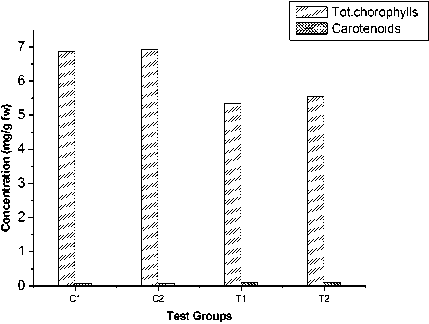
Figure 1 Concentration of Total chlorophylls and Carotenoids in the leaves of Experimental plants. [All of values are mean ± SD based on three independent observations, and bars indicate SD].
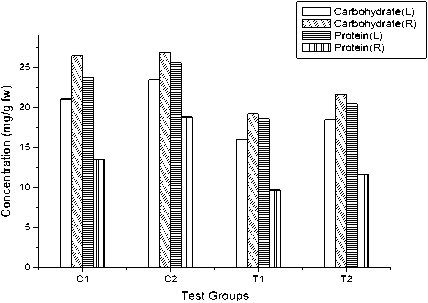
Figure 2 Concentration of Carbohydrates and Proteins in the leaves and roots of Experimental plants. [All of values are mean ± SD based on three independent observations, and bars indicate SD].
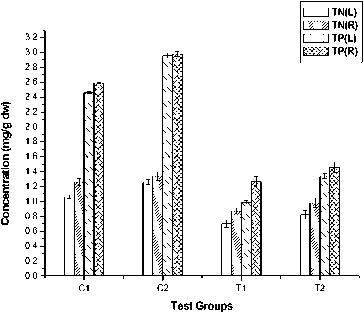
Figure 3(a) Concentration of Total nitrogen and phosphorus in the leaves and roots of Experimental plants. [All of values are mean ± SD based on three independent observations, and bars indicate SD].
Na(L)
Na(R) K(L) mw K(R)

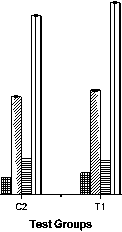

Figure 3(b) Concentration of Sodium and Potassium in the leaves and roots of Experimental plants. [All of values are mean ± SD based on three independent observations, and bars indicate SD].
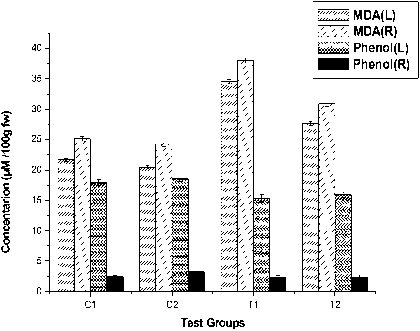
Figure 4 Concentarion of Malondialdehyde and phenol in the leaves and roots of Experimental plants. [All of values are mean ± SD based on three independent observations, and bars indicate SD].
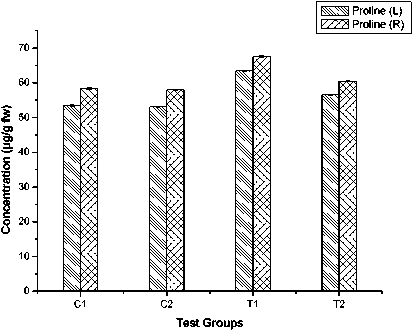
Figure 5 Concentarion of Proline in the leaves and roots of Experimental plants. [All of values are mean ± SD based on three independent observations, and bars indicate SD].
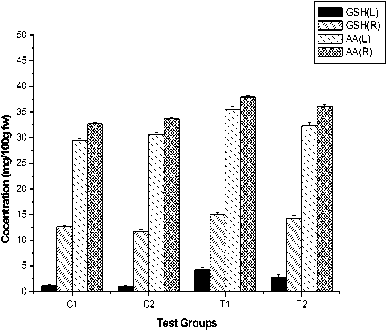
Figure 6 Concentarion of Reduced Glutathione and Ascorbic acid in the leaves and roots of Experimental plants. [All of values are mean ± SD based on three independent observations, and bars indicate SD].
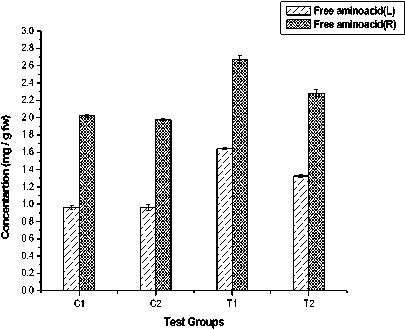
Figure 7 Concentarion of Total Free Amino acids in the leaves and roots of Experimental plants. [All of values are mean ± SD based on three independent observations, and bars indicate SD].
Table. 1. Experimental Design
|
Test Groups |
Treatments |
|
|
Up to 90 days |
Up to105 days |
|
|
C1 |
Tap Water (15 ) |
Tap Water (15 ) |
|
C2 |
Tap Water (15 ) |
Tap Water (15 ) + Ascorbic acid 100mg/10m Distilled water on alternate days for last 15 days |
|
T1 |
Tap Water (15 ) |
Automobile service station effluent (15 ) |
|
T2 |
Tap Water (15 ) |
Automobile service station effluent (15 )+Ascorbic acid 100mg/10m Distilled water on alternate days for last 15 days |
Table II. Chemical characteristics of Effluent before and after treatment
|
Parameters |
Before treatment |
After treatment |
Percentage Removal |
Percentage Removal |
|
|
Effluent |
Effluent |
Effluent+Ascorbic acid |
Effluent |
Effluent +Ascorbic acid |
|
|
TDS (mg L-1) |
62406 |
5156.48 |
2221.2 |
91.7372 |
96.4407 |
|
BOD (mg L-1) |
11.62 |
3.60 |
2.76 |
69.0189 |
76.2478 |
|
COD (mg L-1) |
740 |
206.02 |
192.33 |
72.1595 |
74.0095 |
|
NO 3 -N (mg L-1) |
0.68 |
0.17 |
0.16 |
75 |
76.4706 |
|
NO 2 -N (mg L-1) |
0.02 |
BD |
BD |
100 |
100 |
|
TN (mg L-1) |
14.6 |
7.11 |
6.86 |
51.3014 |
53.0137 |
|
NH 4 -N (mg L-1) |
6.4 |
3.14 |
3.03 |
50.9375 |
52.6563 |
|
Inorganic Phosphorus (mg L-1) |
2.47 |
0.89 |
0.87 |
63.9676 |
64.7773 |
|
Total Phosphorus (mg L-1) |
4.44 |
1.43 |
1.40 |
67.7928 |
68.4685 |
|
Oil and Grease (mg L-1) |
527.16 |
120.83 |
111.18 |
77.0791 |
78.9096 |
|
Silicate (mg L-1) |
25.8 |
14.21 |
13.77 |
44.9225 |
46.6279 |
|
Sulphate (mg L-1) |
172.6 |
63.20 |
60.39 |
63.3835 |
65.0116 |
|
Chloride (mg L-1) |
184.9 |
93.06 |
90.64 |
49.6701 |
50.9789 |
|
Ca (mg L-1 as CaCO 3 ) |
121.6 |
48.06 |
46.18 |
60.477 |
62.023 |
|
Mg (mg L-1 as CaCO 3 ) |
75.5 |
29.08 |
28.34 |
61.4834 |
62.4636 |
|
Na (mg L-1) |
437.5 |
171.58 |
165.41 |
60.7817 |
62.192 |
|
K (mg L-1) |
79.8 |
33.19 |
30.58 |
58.4085 |
61.6792 |
|
Iron (mg L-1) |
10.6 |
3.49 |
3.27 |
67.0755 |
69.1509 |
BD Below Detectable evel.
Table. III. Changes in the Plant Growth Parameters
|
Groups |
Plant Height (cm) |
Root Length (cm) |
Total Wet Biomass (g) |
|
C 1 |
169.7 |
172.6 |
406.4 |
|
C 2 |
171.9 |
173.8 |
417.5 |
|
T 1 |
153.5 |
159.4 |
385.4 |
|
T 2 |
158.8 |
166.1 |
396.5 |
CONCLUSION
The present study reveals that the Vetiveria zizanioides ( .) Nash. is a good candidate for phytoremediation of service station effluent using root zone technology. More than 50% of the pollutants in the effluents were eliminated within 15 days treatment in constructed wetland. The effluent treatment to vetiver plants caused changes in the biochemical and physiological characteristics of the plants, and also it resulted in an increase in the concentration of lipid peroxidation product, malondialdehyde. The study also proved that ascorbic acid (Vitamin C) amendment helped to enhance the defence mechanism against the wastewater induced oxidative stress and associated biochemical changes, so that the pollutant removal efficiency of vetiver is also increased.
ACKNOWLEDGEMENT
Список литературы An appraisal on the stress amelioration of effluent treated vetiver plants amended with ascorbic acid in constructed wetlands
- Al-Hakimi A. B.M. and Hamada A.M. (2011). Ascorbic acid, thiamine or salicylic acid induced changes in some physiological parameters in wheat grown under copper stress. Plant Prot. Sci. 47, 92-108.
- Annonymous. (2009). Eco-Friendly and Non Energy Intensive Technologies for Waste Water Treatment, Eco-Housing Assessment Criteria - Version II, Implemented under Eco-housing Mainstreaming Partnership by IIEC with funding support from USAID, Annexure 6, 1-12.
- APHA. (2012). Standard Methods for the Examination of Water and Wastewater, 22nd ed., APHA- AWWA-WEF. Washington, DC.
- Balakhnina, T.K., Kosohryukhov, A.A., Ivanov, A.A. and Kreslavskil. V., D. (2004). Toxic responses of Cd in higher plants. J. Environ. Biol. 13, 214-215.
- Billore, S. K., Ram, H., Singh, N., Thomas, R., Nelson, R. M. and Pare, B. (2002). Treatment performance Evaluation of Surfactant removal from domestic wastewater in a tropical horizontal subsurface constructed wetland. In: Proceedings of the International Conference on Wetland systems for water pollution control, Dar-es Salaam, Tanzania. 16-19.
- Conklin, P.L. (2001). Recent advances in the role and biosynthesis of ASA in plants. Plant Cell Environ. 24, 383-394.
- Devi, S. R. and Prasad M. N. V. (2005). Antioxidant capacity of Bracssica juncea plant exposed to elevated levels of copper. Russ. J. Plant Physiol. 52, 205- 208.
- Dhanya, G. and Jaya, D.S. (2011). Evaluation of Growth Response and Oxidative Stress Biomarkers in Vetiver grass used for the Remediation of Contaminated Soils. Res. J.Chem. Environ. 15 (2), 1-9.
- Dhanya,G., Jaya, D.S. 2012. Protective effect of ascorbic acid on cadmium induced toxicity in cluster bean Cyamopsis tetragonoloba. L. Taub plants. The Ecoscan, 6(3), 119-124.
- Dietz, K.-J., Kr€amer, U. and Baier, M. (1999). Free radicals and reactive oxygen species ROS as mediators of damage during heavy metal stress. In: Prasad, M.N.V., Hagemeyer,J. Eds., Heavy Metal Stress in Plants: Molecules to Ecosystem. SpringerVerlag, 73-97.
- EPA (2002). The Environment Protection Act- 2002. Standards for Effluent Discharge Regulations. General Notice. No. 44 of 2003.
- Ezhili, N. Manikandan, R. and Venkatachalam, P. (2012). Effects of phosphorus on physiological, photosynthetic pigments and oxidative status in Vetiver grass (Vetiveria zizanioides L). under lead Pb treatment. In: Proceedings of International Conference on Biotechnology, Biological and Biosystems Engineering (ICBBBE 2012) December 18-19, 2012 Phuket Thailand.
- Graham, P. H. and Vance, C. P. (2003). Legumes: importance and constraints to greater use. Plant Physiol. 131 (3), 872-877.
- Gupta, P.K. (1999). Soil, plant, water and fertilizer analysis, Agro Botanica Publishers and distributors, Bikaner, India, pp. 438.
- Hoffmann, H., Platzer, I,C., Winker, I. M. and Muench, E. (2011). Technology review of constructed wetlands-Subsurface flow constructed wetlands for greywater and domestic wastewater treatment. Internationale Zusammenarbeit (GIZ) GmbH Sustainable sanitation - Ecosan program, Eschborn, Germany.
- Imevbore, A.A.A. and Adeyemi, S.A. (1981). Environmental monitoring in relation to pollution and control of oil pollution. In: Proceedings of the seminar on the petroleum industry and the Nigerian environment, 6, 135-142.
- Khan, T. A., Mazid, M. and Mohammad, F. (2011). A review of ascorbic acid potentialities against oxidative stress induced in plants, J. Agrobiol. 28(2), 97-111.
- Koottatep, T., Polprasert, C. and Oanh, N. K. (2010). Design considerations of constructed wetlands for Septage treatment at the ait pilot plant. Asian Institute of Technology Bangkok, Thailand - Urban Environment, Engineering & Managament Program.
- Luna, C. M., Gonzalez,V. S. and Trippi,V. S. (1994). Oxidative damage caused by excess Copper in Oat leaves. Plant Cell. Physiol. 35(1), 11-15.
- Matysik, J., Alia, Bhalu, B. and Mohanty, P. (2002). Molecular mechanisms of quenching of reactive oxygen species by proline under stress in plants. Curr.Sci. 82(5), 525-532.
- Meloni Da, Oliva Ma, Martinez Ca and Cambraia, J. (2003). Photosynthesis and activity of superoxide dismutase, peroxidase and glutathione reductase in cotton under salt stress. Environ. Exper. Bot. 49, 69-76.
- Nagajyoti, P.C., Dinakar, N., Suresh, S.,Udaykiran, Y., Suresh,C. and Damodharam, T. (2009). Effect of industrial effluent on the morphological parameters and chlorophyll content of green gram (Phaseolus aureus Roxb.). J. Exp. Biol. 303, 385-388.
- Navari-Izzo, F., Quartacci, M.F. and Izzo, R. (1990). Water-Stress Induced Changes in Protein and Free Amino Acids in Field-Grown Maize and Sunflower. Plant Physiol. Biochem. 28:531-537.
- Nishikimi, M. and Yagi, K. (1996). Biochemistry and molecular biology of ascorbic acid biosynthesis. Subcell. Biochem. 25, 17-39.
- Ozturk, L.K., Eker, S. and Ozku Hu. (2003). Effect of Cd on growth and concentrations of Cd, ASA and sal phydryl groups in Drum wheat cultivars. Turk. J. Agric. For. 27, 161-168.
- Pandey.S., Gupta, K. and Mukharjee, A.K. (2007). Impact of Cadmium and Pb on Catheranthus roseas - A phytoremediation study. J. Environ. Biol. 28(3), 655-662.
- Raman N.S. and Devotte, S. (2006). Hand book of Indian Environmental Standards. National Environmental and Engineering Research Institute, Nagpur.
- Reed, S. C., Crites, R. W. and Middle Brookes, E. J. (1995). Natural systems for waste management and Treatment. Mc. Graw. Hill Inc., 430.
- Sadasivam, S. and Manickam, A. (1996). Biochemical methods. New Age International Publishers, New Delhi, 110.
- Shaddad, L.M.A., Radi, A.F., Abdul-Rahman, A.M. and Azooz, A. (1990). Response of seeds of Lupines termis and Vicia faba to interactive effect of salinity and ascorbic acid or pyridoxine. Plant Soil. 122, 177-183.
- Shivhare, N. and Roy, M. (2013). Gravel Bed Constructed wetland for treatment of Sewage water. Poll. Res. 32(2), 415-419.
- Starlin, T. and Gopalakrishnan, V. (2013). Enzymatic and Non-Enzymatic Antioxidant Properties of Tylophora Pauciflora Wight and Arn. - An In Vitro Study. Asian. J. Pharm. Clin. Res. 6(4), 69-71.
- Taiz, L. and Zeiger, E. (2002). Plant Physiology (3rd ed.). Sunderland, MA: Sinuaer Associates, Inc.
- Talaat, N.B. (2003). Physiological studies on the effect of salinity, ascorbic acid and Putrescine of sweet pepper plant. Ph.D. Thesis, Faculty of Agriculture, Cairo University.
- Tarraf, S.A., El-Din, K.M.G. and Balbaa, L.K. (1999). The response of vegetative growth, essential oil of lemmon grass to foliar application of ascorbic acid, microtinamid and some micro nutrients. Arab Univ. J. Agric. Sci.7, 247-249.
- Thamizhiniyan, P. Murthy, S.P. and Lakshmanachari, A. S. (2000). Effect of sugar mill effluent and their effects on germination, growth and pigment contents of ground nut and paddy. Ind. J. App. Pure Biol. 15, 151-155.
- Trivedy, R.K. and Goel, P.K. (1998). Practical methods in Ecology and Environmental Science. Environmedia Publications. India.
- Truong, P., Mason, F., Waters, D. and Moody, P. (2000). Application of Vetiver Grass Technology in off-site pollution control: Trapping agrochemicals and nutrients in agricultural lands. In: Proceedings of Second International Vetiver Conference, Thailand, January 2000.
- UN-HABITAT. (2008). Constructed Wetlands Manual. UN-HABITAT Water for Asian Cities Programme, Nepal, Kathmandu, pp. 90.
- West, L. (2006). World Water Day: A Billion People Worldwide Lack Safe Drinking Water. In: http://environment.about.com/od/environmentaleven ts/a/waterdayqa.htm.
- Vipat, V., Singh, U. R. and Billore, S. K. (2008). Efficacy of Root Zone Technology for Treatment of Domestic wastewater: Field scale study of a pilot project in Bhopal (MP), India. In: Proceedings of Taal 2007: The 12th World Lake Conference, 995-1003.
- Zengin, F, K. and Kirbag, S. (2007). Effects of Cu on chlorophyll, Proline, protein and abscisic and level of sunflower seedlings. J. Environ. Biol. 28(3), 561566.
- Zhang,W., Tian, Z., Pan, X., Zhao, X. and Wang F. (2013). Oxidative Stress and Non-enzymatic Antioxidants in Leaves of Three Edible Canna Cultivars under Drought Stress. Environ. Biotechnol. 54(1), 1-8.
- Zhu, Y.I., Elizebeth, A.H., Smith P. and Jerry, J.N. (1999). Overexpression of Glutathione Synthetase in Indian Mustard Enhances Cadmium Accumulation and Tolerance. Plant Physiol. 19, 7380.
- Zirschky, J. (1986). Basic Design Rationale for Artificial Wetland, Contract Report 68-01-7108, US EPA, Office of Muncipal Pollution Control.

